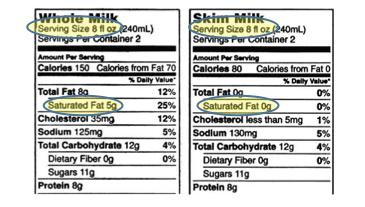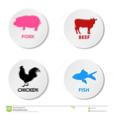Welcome back! So did you figure out the question from Fats 101, part 1’s blog? In case you are a new reader, here is the question.
How many types of fat are required by law to be listed on the food label?
a. 1 b. 2
b. 3 d. 4
THE ANSWER IS B. 2
The nutrition label has always had Total Fats listed. But there are different types of fats. The four main categories of fat are: saturated fat, trans fat, polyunsaturated fat and monounsaturated fat. Of these the two that are required to be listed under total fats are saturated fat and trans fat. These are the fats that tend to raise cholesterol the most.
Today we are going to focus on saturated fats. Saturated fats are usually solid at room temperature. They occur naturally in many products. They are more commonly found in your lard, meat (pork, poultry, beef but amounts vary depending on cuts) and dairy products. Palm oil, palm kernel oil and coconut oil are the few plant based foods that contain saturated fat. Baked goods and processed foods may also contain saturated fat.
To make this even more complicated there are different kinds of saturated fats. Now, we are about to enter the biochemical world so don’t feel you need to memorize all these terms. I am sharing them with you so you can understand why people are debating whether things like coconut oil and butter are good or bad. Dairy products are predominately made up of palmitic acid and meats are mostly myristic acid. Both of these fats have been linked to atherogenesis-plaque in your arteries which causes heart attacks and strokes. Dark chocolate is made of stearic acid and coconut oil is lauric acid. This is where research needs to continue. At this point they aren’t sure if they contribute to atherogenesis or not. Confused yet? Join the club.
So, basically, there are different types of saturated fat. In the future we may hear that some are not as bad for us as others, but, at this time we the official recommendation is to limit saturated fat in your diet. For a healthy individual, the recommendation is for saturated fat to be <10% of your current calories. For instance, if you require 1800 calories per day then 10% of those calories would be the upper limit for your saturated fat intake. That would be 20grams of saturated fat. If you have high cholesterol we would recommend you decrease that to <7% of calories. This would be about 15grams of saturated fat or less per day. This is where a visit to the dietitian can help. We can help you determine calorie and fat needs and how to make this part of a realistic eating plan.
Ok, so you know what saturated fat is, where it is found and how much you should have, but how do we apply this information. First, learn to read the labels. Most of this information is right there. By comparing the food labels you can make the best choice for that particular type of food. Let’s use milk as an example.

First, always check the serving size, you want to make sure you are comparing the same portion size, then find saturated fat on the label and compare. In this case, by switching from whole milk to skim you are saving 5grams of saturated fat per cup.
Some general guidelines to follow are choosing skim or 1% versions of dairy products. When it comes to meat, fish is usually your lowest in fat. Chicken and turkey should be naked (without skin) and the white meat is lower in fat. When looking at red meat loin or round cuts are usually your better choices. I think the easiest way to remember this is what a colleague told me. If you think of animals with no feet, two feet and four feet the no feet animals have the least amount of fat and the four feet the most! Of course always read your labels as they will give the most accurate information.

To get started lowering your saturated fat, start reading the labels in your pantry. Then make a note of which foods you want to see if there is a healthier alternative on your grocery list. When you go to the store, take a few minutes and compare the different options in that food category. You may find there was a tastier/healthier version sitting there the whole time!
The next blog post will focus on Trans Fat so I will leave you with this question:
True or False. If a label says 0g Trans fat then the product does not have any trans fat in it.
